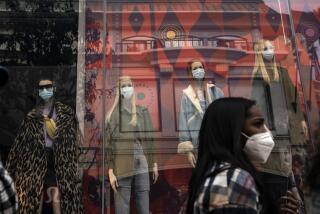Proper medical care can greatly reduce lethality of Ebola virus
- Share via
As international medical providers warned Friday that the Ebola virus threatened to rage “out of control” in West Africa, a top U.S. health official said that proper medical care and infrastructure could greatly reduce Ebola’s lethality.
On Friday, Dr. Anthony Fauci, head of the National Institute of Allergy and Infectious Diseases, said that the species of the current Ebola virus outbreak was very closely related to the so-called Zaire strain -- the most virulent of the five known strains.
While there is currently no vaccine for the disease -- and there is unlikely to be one for at least a year -- Fauci said proper medical care could reduce the rate of death.
“You could have a strain that’s real virulent, like the Zaire strain and in conditions in which individuals don’t go to a healthcare center, don’t get intravenous replacement of fluids, don’t get anti-inflammatories to bring their fever down, don’t get supportive care, and don’t get antibiotics for secondary bacterial infections, those persons may have a mortality rate of 90%,” Fauci said.
However, people with the same disease and access to good medical care stand greater odds of survival.
“The mortality could be down as low as 45, 50, 55 percent,” Fauci said. “So the mortality is influenced not only by whether you are inherently dealing with a virulent strain -- which in this case you are -- but also the accessibility to medical care, particularly fluid replacement.”
Among those cells that the virus targets for attack are the cells that line the interior of blood vessels. The virus injects its RNA into the cells, which then begin producing copies of the virus. In the process, the interior lining of the blood vessels becomes compromised, and hemorrhaging, or bleeding, occurs.
However, it’s not the bleeding that’s lethal, experts say. More problematic is heavy fluid loss in the form of diarrhea and vomiting, and shock.
“When you go into shock, then all of your organ systems fail, your kidneys, your liver, your heart,” Fauci said.
“People don’t die of bleeding, but they do get hemorrhages on the mucosal surfaces and that’s why you see those horrible frightening pictures of people where the whites of their eyes are all bloody. They’re also bleeding from the mouth, and they’re bleeding from the rectum, because they’re mucosal surfaces.”
Access to high-level medical care is the primary reason that two infected Americans, Dr. Kent Brantly and missionary Nancy Writebol, are soon to be airlifted from Liberia and brought to Emory University Hospital, in Atlanta.
At a Friday news conference, hospital officials confirmed that they would be receiving two patients by the end of the weekend, although they declined to state their names.
“We have two individuals who are critically ill. We feel we owe them the right to receive the best medical care that is available to them,” said Dr. Bruce Ribner.
The patients will be cared for in a specially constructed isolation ward that is virtually air tight and designed to handle patients with highly infectious and dangerous diseases.
Ribner, who oversees the ward and is a professor in the infectious disease division at Emory, said he was “cautiously optimistic” that the Americans would be treated successfully.
“We just have to keep the body alive long enough for the body to survive this infection,” Ribner said.
Much of the difficulty in formulating a cure for the disease owes to its sporadic occurrence in remote areas, as well as its sudden onset and high mortality rate.
While researchers have yet to determine conclusively what its natural reservoir is, fruit-eating bats are a prime suspect, while apes, monkeys and antelopes can also carry the disease. The illness usually jumps to humans through the handling or eating of infected animal carcasses or the eating of bush meat.
Typically, an infected individual will experience flu-like symptoms such as fever, muscle aches and sore throat, anywhere from two days to three weeks after exposure. As the illness progresses, patients suffer bleeding and rashes, among other symptoms.
Once humans are infected, the disease is usually passed along to family members, or healthcare providers through bodily fluids, including blood or semen, or through infected medical equipment such as hypodermic needles.
However, medical officials say the disease is not spread through the air, and the chance of the illness spreading here as a result of the patients’ repatriation is remote.
“Given the healthcare infrastructure and our ability to isolate people who are infected and to take care of them with the proper protective equipment, it is extraordinarily unlikely that there would be an outbreak in the United States so people should not worry,” Fauci said. “It’s the lack of healthcare infrastructure that leads to the problems.
Follow @montemorin for science news








